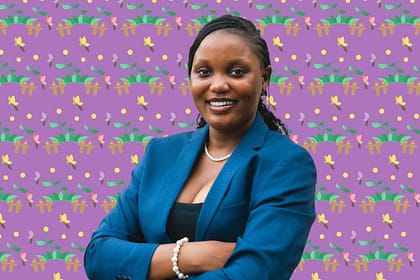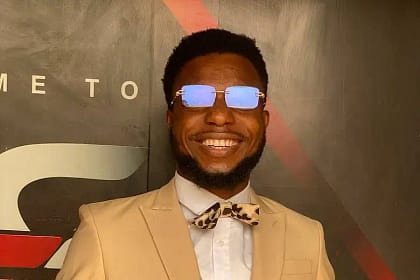Imagine a world where art isn’t just a visual experience but a reflection of life itself. For Ebuka Pascal Agudiegwu, creativity and reality are inseparable, and every moment becomes a canvas waiting to be explored. In this edition of The Lane, Ebuka speaks with Haneefah Abdulrahman about the inspirations behind his vibrant art, the freedom of creation, and the stories that breathe life into his masterpieces.
HANEEFAH ABDULRAHMAN: The definition of art is ever-evolving, and its meaning shifts depending on who you ask. What does art mean to you?
EBUKA PASCAL: Art is life. It’s everything and anything we do. Art is the reason we know what we know and do what we do. Without art, there would be no religion, no culture, no way of life, no reason to live. There’s no real difference between the way I create my paintings and the way a chef cooks food. The act of cooking is also an art; when you think of the recipe and the process, it makes sense. The religious books we read are also works of art, filled with stories, parables, and history. Even our sense of self today is shaped by art, whether oral or written. Some say the creator is the ultimate artist, and we are the creations experiencing life. To me, art and life are the same.
The first time you touched a brush to canvas, what impulse fueled your creative expression?
Honestly, the first time I held a brush, I was anxious. There was no intent to create. I was focused on recreating and chasing perfection. It took me years to realise that true creation comes from freedom. You have to be like a boat without an anchor. The impulse to create is something I developed gradually, and I still work daily to master the act of making something out of nothing, or out of something new.
What challenges have you faced on your journey as an artist?
Many. The first was convincing my parents, who wanted something “more dignified” for me other than art. Later came the struggle of staying true to myself versus chasing trends. Having your own voice as an artist isn’t as easy as people think. Clients and audiences often want you to create in certain ways, and those demands constantly test your integrity. But I believe in the importance of authenticity. Imagine if Van Gogh hadn’t stayed true to his vision, art history would be very different.
Every artist has a distinct style and theme. How would you describe yours?
I call my style Figurative Surrealism. I love figures, and I love the dreamlike quality of surrealism. My themes often revolve around nature, history, identity, fantasy, and mythology. I’m spontaneous, so my narratives are fluid. I try to create works that can mirror someone’s thoughts, open enough for personal interpretation.
You’ve described art as both confrontational and reflective. What’s the backstory of that philosophy?
I believe that when you stand before an artwork, you’re not just looking at it, you’re experiencing yourself through it. Your reaction comes from your past, your desires, or even your future thoughts. Art reflects us and amplifies our beliefs. For instance, I’m drawn to Salvador Dalí because of the dreamlike nature of his work, which mirrors my own imagination.
What’s the most unconventional creative risk you’ve ever taken?
I don’t really see art as risky. Every work of art requires unconventional methods, and that’s encouraged. At this stage, I view every step of making art as worthwhile, there’s no “ruining” art. So, to me, what others call risk is just part of the creative process.
One of your works is titled A Whimsical Folklore. What role does folklore play in your art?
Folklore was one of my earliest encounters with art. As a child, I was told stories about beings and places that weren’t real, yet they stirred our imagination and challenged our sense of reality. Folklore creates energy, especially for children and creative minds, an energy that allows us to believe in imagined things strongly enough to bring them into existence.
In works like All for My Ego, My Heart Skips a Beat, Stuck in Dufuna, and Corridors of Excitement, you often portray women. What is the connection between your art, women, and the feminine world?
I grew up surrounded by women. My mom, siblings, cousins, and friends. In fact, my cousin Amarachi convinced me I was good enough to pursue art. My connection to women in my art began when I started painting female figures with tree twigs sprouting from their heads. Women are the portal through which we all exist, just like trees reproduce fruit. Over time, that connection became a central part of my artistic narrative.
Your 2020 piece Oge Nwanyi features a naked woman wrapped in roots with leaves sprouting from her heart. What’s the story behind it?
Oge Nwanyi, which translates to “a woman in her prime,” challenges the idea that a woman’s worth is tied to her beauty or a so-called biological clock. I wanted to critique the pressure society places on women to bloom and fade according to others’ expectations. For me, a woman’s essence should not be reduced to her physical appeal. It’s deeper than that.
What’s the most unusual source of inspiration you’ve had?
An Igbo proverb: “uche bu akpa, onye obula nya nke ya”, which means “the mind is a bag and everyone carries their own.” From this, I created My Heart Skips a Beat, even using a rat as a metaphor for how thoughts gather and gnaw at us.
What’s a typical day like when you’re fully immersed in your creative process?
It’s almost like a ritual. I wake up, brush my teeth, bathe, do chores, and head to my studio. Some days I finish old pieces; other days I start new ones. I don’t force myself. I create because I feel like it, and luckily, I feel like it every day. I take breaks when I need to, but the studio is always alive with unfinished work and new ideas.
Which of your works feels most personal to you?
The Tip of the Top of the Tip. It hangs in my corridor, and I live with it daily. It represents my current journey, so I see myself in it every day.
If you could go back in time, what would you do differently?
Nothing. My life isn’t perfect, but I wouldn’t change it. Each new day gives us a chance to do things differently, that’s why it’s called “the present.” I try to make the most of the moment without regrets.
How satisfied are you with what you’ve achieved so far, and what keeps you going?
I can’t measure satisfaction, but I can say I’m happy. Of course, I have expectations for myself; that’s what drives me, like staying glued to a movie to see how it ends. My small achievements make me happy too, and they’re part of the reason I keep creating.








